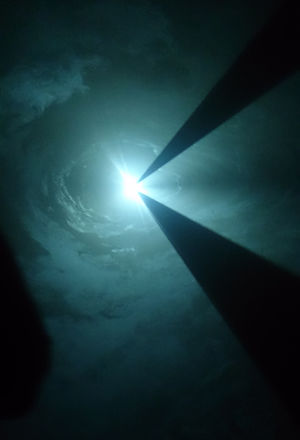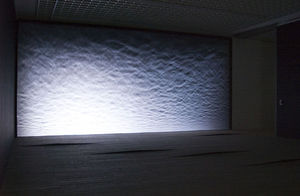Reflection Master Class EYE
Anthony’s Happening
I not going to explain who Anthony McCall is, after the overload of information that we had before and after the master class. We know enough of his minimal, lighting work and 70’s background, so let’s discuss his oeuvre related to others artworks and artist. McCall mention The Happening from Allan Kaprow and performance work from the Fluxus during his lecture. His early films are inspired by them, but now and days his work have a different experience then performing art. It is indeed ‘an happening’, on first side (or photos) you think there are visual effects projected on a wall in an dark room, but when you step ‘inside’ of the works it becomes alive, for me it becomes ‘an happening’. Not like the happening of Allan, or Fluxus, but McCall created his own magical world where everybody is welcome to join. Your welcome to experience the lighting and fog in a different dimension en duration. His idea of solid light film is already 20 years old, and still timeless and contemporary. This digital era works in his favour, to experiments with fog and mist, and analogue film versus digital.
Olafur Eliasson is also an artist who experiments with physical phenomena, like light and water, movement and reflection. Is saw the work ‘Notion Motion’ of this Danish artist in Boijmans van Beuningen museum. In the 1500m2 large installation Eliasson visualized light waves, which made by light and water. The light in the dark room creates a special reflection of the water in white canvases. As a visitor you make a major contribution to the artwork. Above the water are bulging shelves, when you walk over them the light waves will change. I see a relation between the work of Eliasson and McCall’s, there big lighting installation/ projections, both black and white, minimal, use of natural items. ect. But not only the looks they have in common, the important aspect of both works is that the speak the same language. The speak directly to everyone, to children, young people and adults, who are captivated, each in their own way, each with their own understanding, by experience of looking and touching sculptures of light.
It’s hard to discuss this kind of ‘experience art’ because you have to be there, but I think James Turrell work fit also in this row. Let’s take for example the work Floater 99 what’s famous in the Centre for International Light Art and in the permanent collection of the museum. It belongs to the series of works called ´Shallow-Space Construction Series´. It deals with the perception of the three-dimensional space and light. It´s features a glowing purple light that dissolves over time. The only thing you see is an LED screen with lights that softly change blue to magenta red. This colourful installation has not only the same language as Eliasson and McCall, but also duration is an important part of Turrell work as well.
Sources:
Anthony McCall - Breath [the vertical works]
http://www.cultuurbewust.nl/kunst-4815-water-en-licht-versmelten-in-notion-motion/
http://www.lichtkunst-unna.de/en/collection/turrell-james-2001.html



